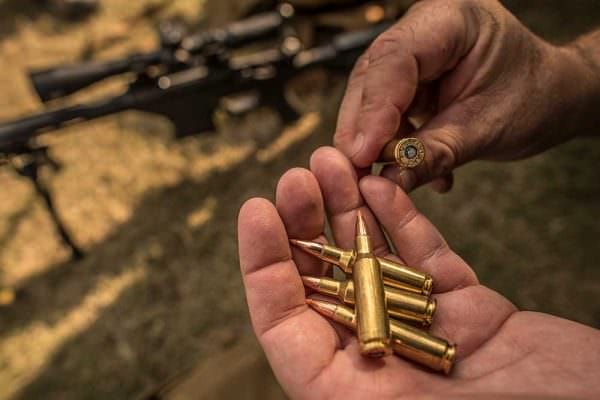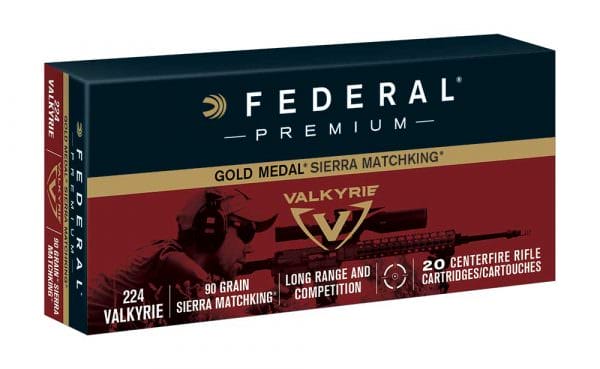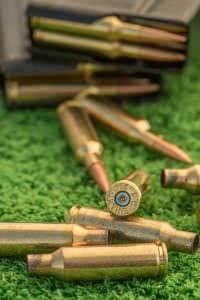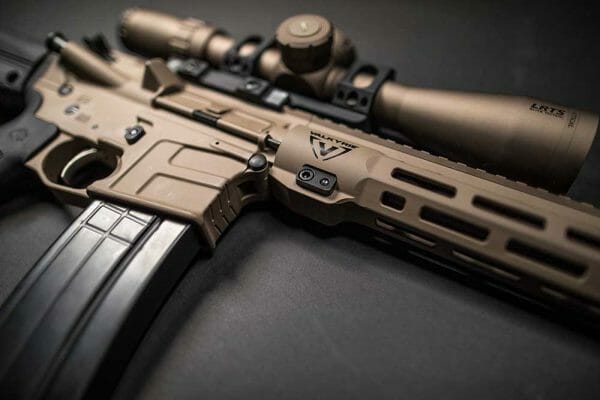How the newest MSR 15 round outpaces all of its competition

U.S.A. –-(Ammoland.com)- Federal Premium’s new 224 Valkyrie cartridge transforms the MSR 15 platform into a 1,000-yard tack driver, unleashes shooters’ full downrange potential and shatters the boundaries of ballistic performance.
Initially available in a 90-grain Gold Medal Sierra MatchKing, 60-grain Nosler Ballistic Tip Varmint, 90-grain Fusion MSR and 75-grain American Eagle TMJ, the lineup offers a bullet for everything from casual target shooting to serious competition and hunting everything from varmints to medium-size game like deer and hogs.
But how does the cartridge’s ballistics stack up to similar and even larger competition?
Coming In Hot
The 224 Valkyrie is fast. A round loaded with the 90-grain Gold Medal Sierra MatchKing produces a muzzle velocity of 2,700 feet per second; it maintains a blistering 1,950 fps pace at 500 yards and 1,359 fps when crossing the 1,000-yard line. In fact, it remains supersonic (faster than the speed of sound) past 1,300 yards. Velocities are based on 24-inch test barrels with a 1:7 twist.

Sustaining bullet speeds faster than the 1,125 fps speed of sound during long-range flight is critical to maximum accuracy. For starters, a projectile is more efficient and easier to put on target at higher speeds. But the transition from super- to subsonic flight (slower than the speed of sound) can also destabilize the bullet, causing it to tumble like a poorly thrown football instead of spinning in a perfect spiral like it does at supersonic speeds. Such destabilization wreaks havoc on accuracy, causing downrange performance to plummet.
“The longer you can fly faster than the speed of sound, the more you can maximize the accuracy and ballistics the bullet is designed to provide,” says elite long-range shooter and Federal Premium Brand Ambassador Jim Gilliland. “Once a bullet falls into subsonic flight, it’s much harder to hit your target.”
For its part, the 224 Valkyrie 60-grain Nosler Ballistic Tip Varmint yields a muzzle velocity of 3,300 fps, maintains supersonic flight to 780 yards and still cruises along at 934 fps at 1,000 yards. The 75-grain American Eagle TMJ leaves the barrel at 3,000 fps and zips by at 1,779 fps at 500 yards, while the 90-grain Fusion has an estimated 2,700 fps muzzle velocity remaining supersonic out to 975 yards. Again, all velocities are based on 24-inch test barrels with a 1:7 twist.
Compelling Comparisons

To put the Valkyrie’s performance into perspective against other match loads, a 223 Rem. 69-grain Gold Medal Sierra MatchKing produces a respectable 2,950 fps muzzle velocity, but slips into subsonic flight just 775 yards downrange—more than 500 yards less than the supersonic range of the 90-grain Sierra MatchKing 224 Valkyrie. Likewise, the 77-grain Custom Competition 22 Nosler rips from the muzzle at 2,950 fps, but quickly loses momentum before dropping below the sound barrier at 875 yards.
Still, on the MSR 15 platform and in the 6.5mm class, a 130-grain Gold Medal Berger AR Hybrid 6.5 Grendel offers a 2,400 fps muzzle velocity and supersonic range of 1,100 yards, which also falls short compared to 224 Valkyrie.
The 224 Valkyrie also holds its own against popular 6mm rounds built for larger MSR 10 rifles.
For example, a 108-grain Berger BT Target in 6mm Dasher produces a 2,950 fps muzzle velocity and 1,350-yard supersonic range, while the 115-grain DTAC in 6XC has a 2,950 fps muzzle velocity and stays supersonic out to 1,380 yards. While these numbers slightly surpass those of 224 Valkyrie, neither of these cartridges were designed to shoot in the MSR 15 platform.
Valkyrie even stacks up favorably against much larger, harder-kicking MSR 10 cartridges like the 6.5 Creedmoor. The 130-grain Gold Medal Berger AR Hybrid 6.5 Creedmoor has a 2,875 fps muzzle velocity and remains supersonic out to 1,400 yards; its 140-grain American Eagle open-tip match counterpart in 6.5 Creedmoor yields a 2,700 fps muzzle velocity and 1,280-yard supersonic range.
Max BCs
The 224 Valkyrie is designed around bullets featuring incredibly aerodynamic designs, which is reflected by their ability to score the kind of sky-high ballistic coefficient (BC) ratings typically produced only by larger caliber bullets. BC refers to a characteristic value that describes how well a bullet flies through the air. The higher the number, the better it flies.
The 90-grain Sierra MatchKing leads the 224 Valkyrie lineup with a G1 ballistic coefficient of .563, which is noteworthy for virtually any bullet and exceptional for short-action rounds. In comparison, the 223 Rem. 69-grain Sierra MatchKing scores a G1 BC of .301 and even the 22 Nosler 77-grain Custom Competition round tops out in .340 BC territory. In the 6.5mm arena, BCs range from .421 to .564.
Other 224 Valkyrie offerings also offer admirable aerodynamics. The 75-grain American Eagle TMJ achieves a .400 BC and the Nosler Ballistic Tip Varmint, while lower, still registers a solid BC of .270. Such efficient flight produces higher downrange velocities and greater energy on impact, with less bullet drop.
In practical terms, elevated BCs help the bullet shoot flatter, buck the wind better and hit harder when it reaches the target. For example, at 1,000 yards the 224 Valkyrie 90-grain Gold Medal Sierra MatchKing experiences just 92.8 inches of drift with a 10 mph crosswind and drops 350 inches en route to the target. In comparison, the American Eagle 120-grain open-tip match 6.5 Grendel drifts 120 inches and drops 410 inches at the same range, under the same conditions.
The story is much the same with other small-caliber cartridges, meaning the only way to experience ballistics similar to those of the 224 Valkyrie is upsize to a heavier, more expensive MSR 10 platform paired with a larger-caliber round such as the 140-grain American Eagle 6.5 Creedmoor—which drifts 92.7 inches and drops 352 inches.
More Punch, Less Kick
The 224 Valkyrie also packs plenty of punch. For example, the 90-grain Gold Medal Sierra MatchKing packs 1,457 foot-pounds of energy at the muzzle and retains 369 foot-pounds of that force at 1,000 yards.
The 224 Valkyrie 60-grain Nosler Ballistic Tip Varmint delivers 1,451 foot-pounds of force at the muzzle, 377 foot-pounds at 500 yards and 116 pounds at 1,000 yards; the 75-grain American Eagle TMJ has 1,499 foot pounds of energy at the muzzle, 619 foot-pounds at 500 yards and 232 at 1,000 yards. Of most importance to hunters targeting medium game like deer and hogs, the 90-grain Fusion produces 1,457 foot-pounds at the muzzle, retains 605 foot-pounds at 500 yards, and 250 foot-pounds as it falls below supersonic at 975 yards.
On the recoil front, 224 Valkyrie provides comparable ballistics as larger counterparts like the 6.5 Creedmoor—but with as little as half the felt recoil.

For example, Federal Premium’s free-recoil calculations—based on firearm weight, bullet weight, charge weight and muzzle velocity—reveal that when shot from a scoped Savage MSR 15 Recon rifle weighing 9.64 pounds, the 90-grain 224 Valkyrie Gold Medal Sierra MatchKing generates just 4.35 foot-pounds of felt recoil. Other 224 Valkyrie rounds produce similar amounts. The 60-grain Nosler Ballistic Tip Varmint produces 4.25 foot-pounds of recoil, while the 90-grain Fusion MSR generates 4.35 foot-pounds and the 75-grain American Eagle TMJ moves the needle just 4.51.
In comparison, a 6.5 Creedmoor 130-grain Berger AR Hybrid OTM cartridge shot from a similar platform produces more than 10 pounds of recoil. Even the 6.5 Grendel loaded with the same bullet yields nearly 7 pounds of force.
The 224 Valkyrie’s mild recoil isn’t just easy on the shoulder. “Lower recoil allows you to see where your shots are going through the scope and make follow-up shots as needed, rather than having to reset your sight picture like you might have to with a heavier recoiling round,” explains Federal Premium development engineer Jacob Burns.
“It’s just another example of how Federal Premium’s new 224 Valkyrie is going to help shooters get more from their MSR 15,” he adds. “More long-range accuracy, more consistent performance—and more fun.”
Flight of the Valkyrie
A look at the 90-grain Sierra MatchKing 224 Valkyrie’s dope card provides more insight into the cartridge’s performance. With baseline factors including 29.92 barometric pressure, 0 percent humidity, an air temperature of 59 degrees Fahrenheit and 10 mph average crosswind, the round racks up consistent ballistics throughout its 1,300-yard journey.
The bullet covers 100 yards in 0.11 seconds. It arrives traveling 2,539 feet per second with 1,288 foot-pounds of energy. Windage is virtually a non-factor at 0.67 inches. At 500 yards, flight time is 0.65 seconds and velocity is 1,950 fps. The bullet packs 760 foot-pounds of energy and drops 57 inches (with a 100-yard zero), while windage rises slightly to 19.32 inches. The 224 Valkyrie crosses the 1,300-yard line in 2.31 seconds (Mach 1.005), with a velocity of 1,122 fps and 252 foot-pounds of energy. Drop is 733 inches and windage is 173.47 inches.
The 224 Valkyrie is based on a 6.8 SPC case (necked down to .22 caliber), but comparing the two cartridges is an apples-to-oranges proposition. Designed by Special Forces personnel to increase the firepower of an M4 carbine, the 6.8 SPC uses a 0.277-inch diameter bullet and is based on a shortened version of the now-obsolete 30 Rem. case.
“The 6.8 SPC does not lend itself to using high-BC bullets for extended long-range shooting,” Burns explains. “With the 6.8 SPC, you’re launching a short .277 or 6.8mm caliber, 90-grain projectile with a lower BC at 2,850 fps. The 224 Valkyrie has a long .224 or 5.56mm caliber, 90-grain projectile with a very high BC that leaves the muzzle at 2,700 fps. When designing the Valkyrie, Federal Premium engineers didn’t consider the 6.8 SPC a comparable load. Instead, we aimed to beat the long-range ballistics of the 223 Rem., 22 Nosler and 6.5 Grendel.”
More Benefits
Besides stellar ballistics, the 224 Valkyrie packs an economical punch as well, significantly reducing the cost of 1,000-yard precision shooting for fun and competition. Suggested retails for a box of 20 224 Valkyrie rounds run from $31.95 for the 90-grain Gold Medal Sierra MatchKing down to just $ 13.95for the 75-grain American Eagle TMJ. In comparison, 6.5 Creedmoor ammunition within the Federal Premium family costs from $51.95 per box for 140-grain Nosler AccuBond to $26.95 for 120-grain American Eagle open-tip match.

MSR 15 platforms also cost less than their larger MSR 10 counterparts. For example, in the Savage Arms lineup, an MSR 15 Patrol in 223 Wylde carries a suggested retail of $868 and the MSR 15 Recon costs $999. In comparison, a Savage MSR 10 Hunter chambered in 6.5 Creedmoor retails for $1,481 and an MSR 10 Long Range runs $2,284.
In the end, the advantages 224 Valkyrie offers in ballistics, recoil, accuracy and economy don’t just make this hotshot new cartridge different for the sake of different. They make it hands-down the best performing MSR 15 cartridge ever conceived—perfect for anyone who wants to shoot farther, more accurately and more effectively than ever before.

What about performance from 16″ AR barrel? Article talks about AR-15 platform,but gives ballistics from 24″ barrel
How’s this any different than 223 WSSM
have to watch this one. This could lead to be a nice light weight accurate varmet round.
The 6.5 Creedmoor created a shortage of H4350, wonder what powder shortage the 224 Val is going to create? Have firearms enthusiast turned into techno geeks that think they have to own the latest and greatest created every year? My answer to the 6.5 Creedmoor and 224 Val is my old and accurate 270 Winchester and 220 Swift … I really don’t need an MSR platform for every form of hunting and target shooting that I’m engaged in!
Worth trying in my Remington 700 now chambered in .223 with a 26″ barrel. Add a new scope and 20 moa rail for a great varmint rifle.
The entire synopsis is skewed by the use of a 24″ barrel to justify cartridge performance. Me thinks that taking the Soviet/Russian 5.45mm×39mm cartridge and creating brass cased performance loads would do most, if not all, the listed performance of this 224 Valkyrie. Besides….there are many 5.45mm×45mm chambered weapons already in the hands of citizens.
Dedicate developmental resources to tweaking the 5.45mm and creating brass cased ammo for the cartridge.
More parts, More changes !
Figure out what you use your rifle ,
for and build it , practice with it till it
feels like its part of you and leave it Alone !
All these changes make for a waiting accident !
Wrong rounds in your old faithful go boom in face !
Sounds good! Who else makes Ammo and uppers for it?